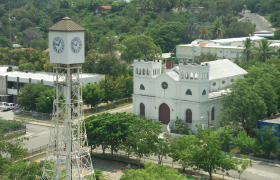
Montecristi
Montecristi was discovered by Admiral Cristóbal Colón on his first trip. The salt mines stand out in its landscape, offering a dazzling view. Also, as part of the landscape, the Montecristi National Park, a subtropical dry forest, with an abundant variety of vegetation and rich fauna. 11 reptile species live there, including the American crocodile and numerous birds, among which the pelican, the flamenco, the earwig, the pigeon and the swallow abound.
 Flocks of birds arrive every year to its seven cays, called “Los Siete Hermanos,” from Florida. El Morro has an impressive magnificence and beauty, with views to the entire bay and its keys and its system of coastal lagoons.
Flocks of birds arrive every year to its seven cays, called “Los Siete Hermanos,” from Florida. El Morro has an impressive magnificence and beauty, with views to the entire bay and its keys and its system of coastal lagoons.
One of its great tourist attractions is the estuaries or navigable channels covered with mangroves. Caño de Estero Hondo stands out because of the presence of more than 20 manatee species, an endangered marine mammal.
The area also has a scientific reserve in Villa Elisa; the famous last-century mechanical clock and the museum of Dominican General Máximo Gómez and Cuban liberator José Martí. The Victorian architecture of the main city, San Fernando de Montecristi, stands out.
Montecristi has a good hotel accommodation offer. Its gastronomic proposal features modern, fresh and competitive options, such as the one offered by Lilo Café Restaurante.
Centro de Interpretación de La Sal is considered an excellent initiative to diversify the local tourist offer that takes up this cultural element surrounded by an exquisite natural wealth. The visit to the Center begins with the spectacular view of El Morro and continues with the sighting of an important onsite bird population that includes pink flamingos, spoonbill sandpipers, and blue herons, among other species. It ends with a tour of a wooden platform that contains information on the timing of the salt extraction process and how this ecosystem works.
Montecristi has a Tourist Information Center (CIT for its acronym in Spanish) located at Casa Doña Emilia.
Did you know? Montecristi has the only Centro de Interpretación de la Sal in the country, where you can learn how more than four generations have produced handmade sea salt from sea water.
Did you know? Casa Doña Emilia was taken apart and brought from Paris in 1895 and put back together in Montecristi where it became an architectural jewel, to this day. Montecristi has a Tourist Information Center (CIT) at Casa Doña Emilia.
The cluster of this destination recommends the following, from a diversity of activities, routes and excursions in Montecristi:
- El Morro and Los Caños. It is a sea excursion that allows you to enjoy a journey through the mangroves and the Esteros (estuaries) or Caños de Montecristi. The tour includes a visit to Isla Cabra and the return to El Morro National Park from the high seas. The tour offers the opportunity to go trekking in the old Salinas of Isla Cabra or hiking to the top of El Morro.
- 7 Cayos Route. This tour departs by boat from San Fernando de Montecristi, located in Playa Juan de Bolaños, or from Manzanillo. The Siete Hermanos Cayo Wildlife Refuge is located across the Montecristi Bay, five kilometers offshore from Punta Luna. This tour can be completed in 5 hours.
Did you know? Cayos are a nesting refuge for the red-legged gulls, a first-class attraction for bird watchers. Visitors are especially interested in watching the large population of brown noddies. It is also the habitat for other species such as pelicans, earwigs, white-crowned pigeons, mangrove canaries, reptiles and mammals. A wide variety of sponges, coral fish, sea turtles such as hawksbill turtles, pink conchs, crabs, and lobsters inhabits the coral reefs.
- Los Manzanillo Route. There are many natural attractions that can be visited in this tour: The Estero Balsa National Park; the Manzanillo Bay (1.5 hours from Montecristi); La Laguna Saladilla Wildlife Refuge Reserve (1 hour from Montecristi), and the Manzanillo Beach and Pier, among others.
- Historical Route. It consists of a tour of the Historic Center, shops, museums and the local community of Montecristi.
- Gastronomic routes:
- The Chivo Liniero Route: This route involves the visitor in the best known gastronomic tradition of the region, which is goat prepared in all its forms, with lots of oregano and hot pepper. Visitors are recommended to make a mandatory stop and taste the Dominican flavor of this delicacy.
- The Seafood Route: It allows visitors to gain a wider picture of the gastronomy in the province when tasting dishes prepared with seafood, prepared with a typical flavor. There are many places with views of the sea. It is a recommended tour during any stay in Montecristi.
- Parque Nacional Subacuático Route. This route leaves by boat from Juan de Bolaños Beach in Montecristi or from Buen Hombre Beach; it is a unique experience to enjoy the most important coral reef and the country’s ecosystem. Sport and scientific diving, sailing, snorkeling and swimming are allowed. The route may include, by land, a visit to the Villa Elisa Scientific Reserve: there are unique species of endemic Dominican flora, such as the cacatica orchid.
Montecristi has a tourist cluster that offers a variety of information about the destination. You can also find information on the area’s gastronomic, cultural, historical and hotel offers.
Links of interest:
Tourist Cluster of Montecristi: http://venamontecristi.com/


